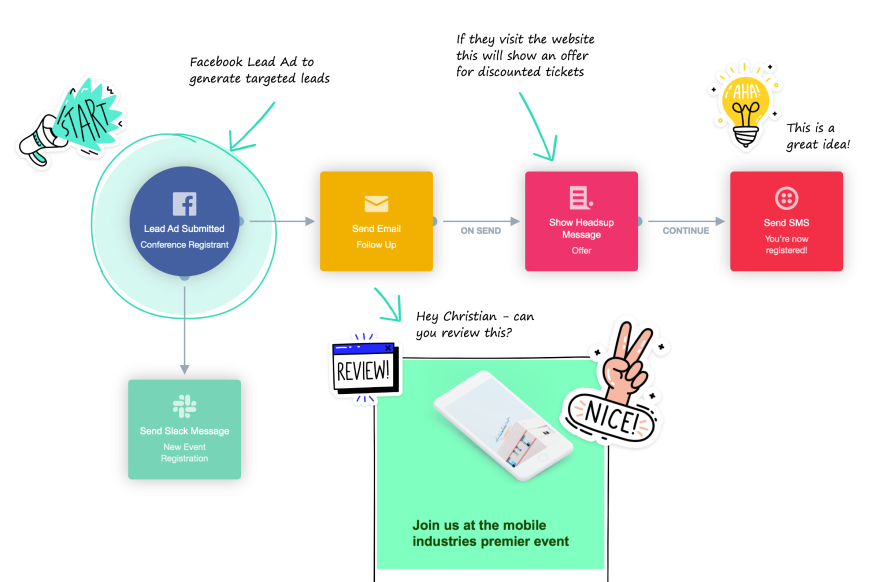5 High-Value Examples of Agile Marketing Automation
Image

Agile marketing tactics let you market faster — that means iterate and test faster, respond faster, and create a reliable understanding of your customers faster. In this post we’re going to talk about five areas that you can transform with agile marketing automation.
Before we jump in, though, let’s make sure we’re clear on what we mean by “agile marketing,” “marketing automation,” and “martech stack.”
Agile marketing: Agile marketing grew out of Agile software development. It’s an iterative and adaptive process: small, cross-functional, and largely self-directed teams work in short cycles while incorporating rapid feedback. In marketing automation, the process depends on sharing data across stacks rather than relying on individual automation platforms. This method is aimed at maximizing resilience, responsiveness, and customer visibility.
Marketing automation: automating marketing activities using software.
Marketing technology stack/martech stack: The software tools you use for marketing, and how they’re organized.
#1 Customer Data Enrichment
Marketing agility depends on getting the best insights from your data, and on automating everything you can. For example, we love behavioral analytics, but it’s only part of the picture. Ideally, we want to know who’s doing what, not just the “what,” so we can have some idea of what they’re doing it for. That’s where data enrichment comes in.
We’re going to rave about Segment a bit further down, but one of the things I love about it is you can use Segment’s Enrichment integration category to pass signup data to a data enrichment provider like Clearbit, which automatically enriches customer data from stuff like signup forms or even just a corporate domain, so that way we get the “who.” Then Segment will take that enriched data to Amplitude, and they’ll show you the “what.”
Image

These are all great providers, but for each one there are solid alternatives. It’s not about using these specific tools, but using a group of tools that each deliver a piece of the puzzle well and getting them to communicate so you get the whole picture.
You can apply this same process at different touchpoints along the funnel, creating a data pipeline that constantly sends data downstream and recycles it back to make sure that all your systems are a record of truth. Rather than getting a ton of data on just one aspect of your customers, at just one stage of their journey, you get data you can actually use that stays with them as they move through your stack.
#2 Visualization of Customer Journeys
Visualizations are the best way to grasp things like journeys. If they weren’t, maps would be spreadsheets of coordinates. Imagine trying to navigate from something like that, and you’ll see the importance of not just extracting data from a range of tools, but putting it into visualizations so you can quickly make sense of it and act on it.
Autopilot is our favorite tool for this, for two reasons: one, they have an integration with Salesforce, which in turn has an integration with everything in sales, so we’re helping to break down that sales/marketing divide; and two, their customer journey visualization actually works.
Image

As you can see in the image above, this customer gets a Facebook ad (and the team gets a Slack message), then an email, then a message in the menu on the website, then a text message. This visualization lets us see what someone actually does, and the actions that are taking place as a result, and it keeps a unified view of the customer journey in one place. When you don’t have that, you’re going to get problems.
When I worked with RealThread, they had great inbound and great outbound, but what they didn’t have was a connection between the two. Outbound would be contacting people and driving sales, but the sales were happening on the website. Then, sales would contact those customers offering them incentives off their first order — when they’d just made their first order.
There was no way to connect that outbound prospecting with the fact that people were actually purchasing because of it, and no way to stop stuff like that from happening. That Autopilot/Salesforce hookup doesn’t just improve understanding in some abstract way, or make sales and marketing each perform better; it keeps the whole organization on the same page all the time.
#3 Easy Code Deployment
The trouble with implementing new tracking code of any kind is, you normally have to get a dev involved somewhere along the way. Try to do it yourself, and you often have to get a dev involved to unscrew whatever it is you did. In a way, this goes to the root of the concept of agile: whoever owns it should control it. Marketing owns tracking, so marketing should be able to change it, without hanging around the IT area looking sheepish all morning.
A client-side tag manager is your friend here. Tag managers let you launch new campaigns and integrate new tools faster and more comprehensively, and you can do it without bothering a developer or writing a line of code yourself. Tag managers let you manage and deploy snippets of tracking code (tags) to your site or app without having to amend the code.
It’s possible because the tag manager basically does the “translation” for you. (That’s going to be a recurring theme — tools that automate away marketing infrastructure tasks, not just send your emails for you or whatever.)
This way, you have a tagging infrastructure, where all your tags and pixels share the same information and you can leverage them all across your stack. One tool can talk to another in the same language. Use Google Tag Manager, Tealium, Adobe, any of the other tools out there; but using a client-side tag manager is a crucial step to getting automated and agile.
#4 Data Recycling
Data recycling means using the same data for more than one thing. Example: when LinkedIn wanted to understand how documents were being shared by users (this is in the pre-Pulse days) they didn’t even bother trying to look at the documents. They just looked at who was sharing them. Everyone who read this document is a real estate lawyer? Out on a limb here: probably about real estate law. Point is, they didn’t go get new, bad data. They used the good data they already had for something else.
Moving data around your stack, between tools that are meant for different niche things, is a crucial way to extract maximal value from it by getting insights in new contexts.
Data recycling is your insurance against an outage. A ton of marketers make one tool the central, sole source of accurate knowledge in their stacks. I get the whole “put your eggs in one basket, then watch that basket” concept — but even the most seemingly reliable tool can do down. Think of May this year, when Salesforce — Salesforce! — went down, for 15 hours, and on a Friday to boot. I lost Friday’s and a chunk of Monday’s productivity, but I didn’t lose my accurate marketing data because everything in my whole stack is my record of truth, not just one tool.
Getting this to work relies on getting tools to talk to each other, and they often really don’t want to do that. It’s kind of like they all talk different languages, so getting them to communicate is really hard.
This is what we use Segment for, like a Rosetta Stone that lets a bunch of tools talk to each other without any new code and without glitches. Doing that desilos marketing tools, allowing us to build a stack that communicates so we’re not treating the same customer as nine different people with nine different tools.
#5 Customer Data Platform
At the heart of an agile martech stack is a CDP — a Customer Data Platform. CDPs, marketing databases built ready for a world where it’s raining APIs and stacks number in the dozens of tools, do three main things:
They pull in customer data from across the stack
They match, merge, and clean that data to create a reliable, accurate customer record
They make that record available across the stack
If this is sounding kind of like CRM to you, you’re not alone. Segment thinks so too, and that’s who we use for our CDP. It’s less a central repository, more a railhead; whatever tool you go with, to function it needs to be able to:
Plug and play (and unplug): connecting and disconnecting tools needs to be quick and easy or you’re just making more work
Test and assess tools and integrations rapidly, acting as an entryway to the whole marketing stack
Conclusion
Agile marketing achieves results that weren’t possible before, but it does so with tools that weren’t there before. A new level of integration and personalization is achievable, but it relies on a new kind of automation.
Just automating sending emails, or auto-populating fields in CRM, isn’t going to cut it. Instead, you have to automate the acquisition and manipulation of data itself. No automation, no agile.
If you’re working on the transition to agile marketing, you might want to look at Pantheon’s hosting solutions for agile — or talk to us at Effin about putting a martech stack together!
Topics:
Related blog posts
Agile Marketing Week on the MarTech Podcast
Read More